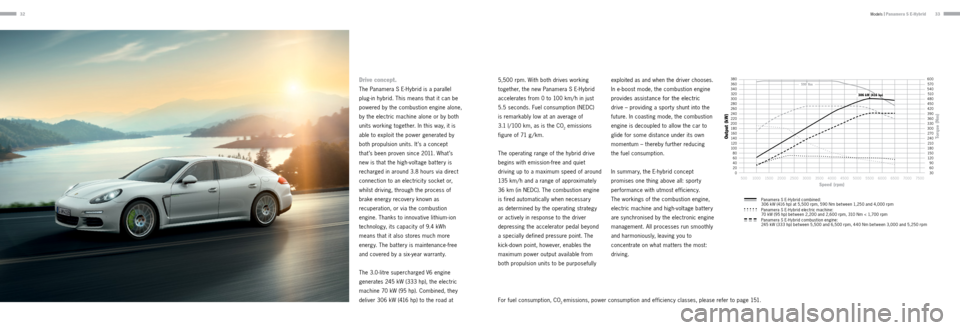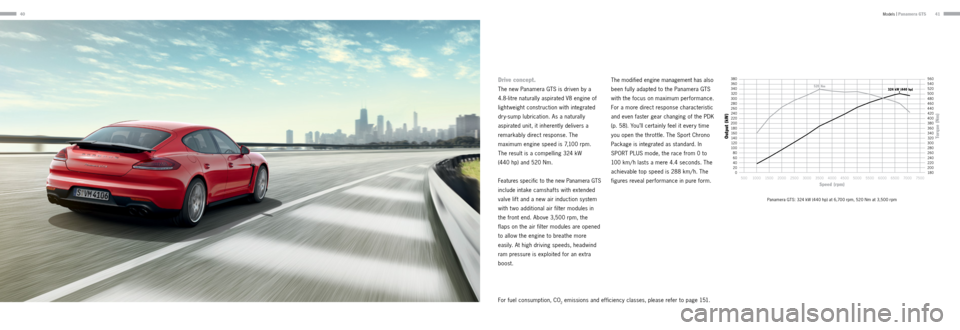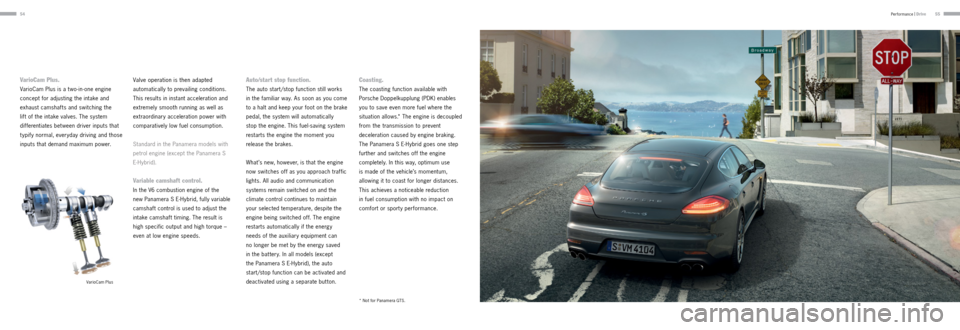2013 PORSCHE PANAMERA torque
[x] Cancel search: torquePage 10 of 78

2021
Drive concept.
The efficient 3.6-litre naturally aspirated
V6 engine with four overhead camshafts
benefits from a lightweight construction.
A balance shaft reduces vibrations and
ensures excellent smooth running. Direct
fuel injection (DFI, p. 53), VarioCam Plus
(p. 54) and integrated dry-sump
lubrication
are fit ted as standard. A
coasting function (p. 54) and auto start /
stop function (p. 54) are also provided.
The engine generates a power output
of 228 kW (310 hp) at 6,200 rpm
and a maximum torque of 400 Nm at
3,750 rpm. The result is a top speed
of 259 km/ h and acceleration from
0 to 100 km/ h in 6.3 seconds in the
new Panamera and a 257 km/ h top
speed and 6.1 seconds from 0 to
100 km/ h in the new Panamera 4.
For fuel consumption, CO
2 emissions and efficiency classes, please refer to page 150.
Models |
Panamera and Panamera 4
Panamera and Panamera 4: 228 kW (310 hp) at 6,200 rpm, 400 Nm at 3,750 rpm
380
360
340 320
300 280260 240
220
200 18 016 0
14 012 0
10 0 8060
40
20
0
500 1000 15 0 02000 25003000 35004000 45005000 55006000 65007000 7500560
540
520
500
480 460
440 420
400 380360
340 320
300 280260 240
220
200 18 0
Torque (Nm)
Max. power (kW)
Speed (rpm)
400
Nm228 kW (310 hp)
Page 13 of 78

2627
Drive concept.
Yes, power is important. Just as important
as efficiency. That ’s why the new
Panamera S and the new Panamera 4S
now come equipped with a newly
developed 3.0 -litre t win-turbo V6 engine.
Thanks to some clever downsizing, the
result is more power output than that of
the naturally aspirated engine in the
predecessor model, yet with significantly
lower fuel consumption.
The lightweight construction of the new
engine also contributes to its high
efficiency. Technologies such as direct
fuel injection (DFI, p. 53), four overhead
camshafts and VarioCam Plus (p. 54) join
forces with t wo turbochargers to deliver
a high degree of efficiency and optimum
torque in every engine speed range. The result is 309 kW (420 hp) with
6,000 rpm, and 520 Nm bet ween
1,750 and 5,000 rpm. The Panamera S
completes the sprint from 0 to 100 km/ h
in 5.1
seconds and manages a top speed
of 287 km/ h. The Panamera 4S reaches
100 km/ h from a standing start in
4.8 seconds and achieves a maximum
speed of 286 km/ h. And that ’s with up
to 18 % less fuel consumption than that
of the respective predecessor model.
For fuel consumption, CO
2 emissions and efficiency classes, please refer to page 150.
Models |
Panamera S and Panamera 4S
Panamera S and Panamera 4S: 309 kW (420 hp) at 6,000 rpm, 520 Nm bet ween 1,750 and 5,000 rpm
380
360
340 320
300 280260 240
220
200 18 016 0
14 012 0
10 0 8060
40
20
0
500 1000 15 0 02000 25003000 35004000 45005000 55006000 65007000 7500560
540
520
500
480 460
440 420
400 380360
340 320
300 280260 240
220
200 18 0
Torque (Nm)
Output (kW)
Speed (rpm)
520 Nm309 kW (420 hp)
Page 16 of 78

3233
Drive concept.
The Panamera S E-Hybrid is a parallel
plug-in hybrid. This means that it can be
powered by the combustion engine alone,
by the electric machine alone or by both
units working together. In this way, it is
able to exploit the power generated by
both propulsion units. It ’s a concept
that ’s been proven since 2011. What ’s
new is that the high-voltage bat tery is
recharged in around 3.8 hours via direct
connection to an electricit y socket or,
whilst driving, through the process of
brake energy recovery known as
recuperation, or via the combustion
engine. Thanks to innovative lithium-ion
technology, its capacit y of 9.4 kWh
means that it also stores much more
energy. The battery is maintenance-free
and covered by a six-year warrant y.
The 3.0 -litre supercharged V6 engine
generates 245 kW (333 hp), the electric
machine 70 kW (95 hp). Combined, they
deliver 306 kW (416 hp) to the road at 5,500 rpm. With both drives working
together, the new Panamera S E-Hybrid
accelerates from 0 to 100 km/ h in just
5.5
seconds. Fuel consumption (NEDC)
is remarkably low at an average of
3.1 l/100 km, as is the CO
2 emissions
figure of 71 g / km.
The operating range of the hybrid drive
begins with emission-free and quiet
driving up to a maximum speed of around
135 km/ h and a range of approximately
36 km (in NEDC). The combustion engine
is fired automatically when necessary
as determined by the operating strategy
or actively in response to the driver
depressing the accelerator pedal beyond
a specially defined pressure point. The
kick-down point, however, enables the
maximum power output available from
both propulsion units to be purposefully
exploited as and when the driver chooses.
In e-boost mode, the combustion engine
provides assistance for the electric
drive – providing a sport y shunt into the
future. In coasting mode, the combustion
engine is decoupled to allow the car to
glide for some distance under its own
momentum – thereby further reducing
the fuel consumption.
In summary, the E-hybrid concept
promises one thing above all: sporty
performance with utmost efficiency.
The workings of the combustion engine,
electric machine and high -voltage bat ter y
are synchronised by the electronic engine
management. All processes run smoothly
and harmoniously, leaving you to
concentrate on what mat ters the most:
driving.
For fuel consumption, CO
2 emissions, power consumption and efficiency classes, please refer to page 151.
Models |
Panamera S E-Hybrid
Panamera S E-Hybrid combined :
306 kW (416 hp) at 5,500 rpm, 590 Nm bet ween 1,250 and 4,000 rpm
Panamera S E-Hybrid electric machine :
70 kW (95 hp) bet ween 2,200 and 2,600 rpm, 310 Nm < 1,700 rpm
Panamera S E-Hybrid combustion engine :
245 kW (333 hp) bet ween 5,500 and 6,500 rpm, 440 Nm bet ween 3,000 and 5,250 rpm
380
360
340 320
300 280260 240
220
200 18 016 0
14 012 0
10 0 8060
40
20
0
500 1000 15 0 02000 25003000 35004000 45005000 55006000 65007000 7500600
570
540 510
480 450420
390
360 330
300 270
240 210
18 0 15 0 12 0 9060
30
Torque (Nm) Output (kW)
Speed (rpm)
590 Nm
306 kW (416 hp)
Page 19 of 78

3839
The new Panamera models reconcile
contradictions. They are vitalised by the
conflict bet ween comfort and dynamics
and bet ween sport y performance and
ef ficiency. Can three let ters intensif y
this conflict? The answer is seen on
race tracks and on roads. That ’s where
Porsche has writ ten the abbreviation
GTS into history – and is how the
new Panamera GTS has become the
thoroughbred athlete of the family.
The figures sum it up: 324 kW (440 hp)
power output and a maximum torque of
520 Nm. The 4.8-litre naturally aspirated V8 engine with ram air induction is
extremely responsive. 7-speed Porsche
Doppelkupplung (PDK) and the active
all-wheel drive of Porsche Traction
Management (PTM) transmit the engine
power of the new Panamera GTS adeptly
to the tarmac. The sports exhaust
system and the adaptive air suspension
with ‘normal level’ lowered by 10 mm
are fit ted as standard. The brake system,
wheels, front end and four-way rear
spoiler have been carried over from
the Panamera Turbo. The sideskirts are
st yled in mat t black. This is driving pleasure the GTS way –
accompanied by a thunderous
soundtrack.
The sport y characteristics of the new
Panamera GTS continue seamlessly into
the interior in the form of leather and
Alcantara and the ‘GTS’ logo in the rev
counter, on the headrests and on the
door sill guards in brushed aluminium.
Alcantara is the material used for the
seat centres of the adaptive Sports
seats, the armrests of the centre console
and the rooflining. The SportDesign steering wheel is fit ted as standard.
On request, it is possible to have the
rim finished in black Alcantara.
Two optional trim packages are available
in conjunction with the black Alcantara.
They further emphasise the sport y
at titude of the interior. The seat belts
and the stitching on the dashboard, door
waist rails, seats, and the armrests on
the centre console and doors are in
Carmine Red or GT Silver. The headrests
of all four seats are embroidered with
the ‘GTS’ logo in the same colour.
How about some extra zing?
The new Panamera GTS.
Models |
P anamera GTS
Panamera GTS with 20 - inch RS Spyder Design wheels
Page 20 of 78

4041
Drive concept.
The new Panamera GTS is driven by a
4.8-litre naturally aspirated V8 engine of
lightweight construction with integrated
dry-sump lubrication. As a naturally
aspirated unit, it inherently delivers a
remarkably direct response. The
maximum engine speed is 7,100 rpm.
The result is a compelling 324 kW
(440 hp) and 520 Nm.
Features specific to the new Panamera GTS
include intake camshafts with extended
valve lift and a new air induc tion system
with t wo additional air filter modules in
the front end. Above 3,500 rpm, the
flaps on the air filter modules are opened
to allow the engine to breathe more
easily. At high driving speeds, headwind
ram pressure is exploited for an extra
boost.
The modified engine management has also
been fully adapted to the Panamera GTS
with the focus on maximum performance.
For a more direct response characteristic
and even faster gear changing of the PDK
(p. 58). You’ll certainly feel it every time
you open the throt tle. The Sport Chrono
Package is integrated as standard. In
SPORT PLUS mode, the race from 0 to
100 km/ h lasts a mere 4.4 seconds. The
achievable top speed is 288 km/ h. The
figures reveal performance in pure form.
For fuel consumption, CO
2 emissions and efficiency classes, please refer to page 151.
Models |
Panamera GTS
Panamera GTS: 324 kW (440 hp) at 6,700 rpm, 520 Nm at 3,500 rpm
380
360
340 320
300 280260 240
220
200 18 016 0
14 012 0
10 0 8060
40
20
0
500 1000 15 0 02000 25003000 35004000 45005000 55006000 65007000 7500560
540
520
500
480 460
440 420
400 380360
340 320
300 280260 240
220
200 18 0
Torque (Nm)
Output (kW)
Speed (rpm)
520 Nm324 kW (440 hp)
Page 22 of 78

4445
Supreme performance can take the
breath away. Or it can force us to
keep calm and breathe deeply. It ’s like
sit ting behind the wheel of the new
Panamera Turbo.
Here, comfort and sportiness intertwine
without compromise. Its 4.8-litre t win-
turbo V8 engine delivers 382 kW (520 hp)
and offers a maximum torque of 700 Nm
bet ween 2,250 and 4,500 rpm. The
new 19-inch Panamera Turbo II wheels
afford a glimpse of the brake system
and its red brake calipers.
520 hp unleashes a mighty force.
The kind to put a smile on your face.
The new Panamera Turbo.
The twin dual-tube tailpipes are in the
unmistakable Turbo design. Just like
the chrome- coloured air outlets behind
the front wheels.
The front end features large air intakes to
increase the volume of cooling air, while
the four-way rear spoiler helps to reduce
lift at the rear axle.
Porsche Doppelkupplung (PDK, p. 58) is
fit ted as standard, as is Porsche Traction
Management (PTM, p. 61) with active
all-wheel drive and an electronic and map - controlled multi - plate clutch.
Displays in the instrument cluster and
Porsche Communication Management
(PCM, p. 92) inform you of the
longitudinal and lateral acceleration
forces currently acting on the vehicle.
Integrated as standard, the adaptive air
suspension including Porsche Active
Suspension Management (PASM, p.
65)
enhances sport y per formance –
or comfort. At the push of a but ton.
In the interior, the Turbo presents its own
interpretation of the sport y st yle that characterises any Porsche. It achieves
this with electric eight-way power seats
(front) with memory package (p. 88),
and seat heating (p. 91) for the driver,
front passenger and also in the rear; and
with an interior in smooth-finish leather
and the walnut interior package. Porsche
Communication Management (PCM)
including navigation module and BOSE
®
Surround Sound System (p. 98) are fit ted
as standard. The High-End Surround
Sound System from Burmester
® (p. 98)
is available as an option.
Models |
P anamera Turb o
Panamera Turbo with 20 - inch 911 Turbo II wheelsFor fuel consumption, CO2 emissions and efficiency classes, please refer to page 151.
Page 23 of 78

4647
Drive concept.
The new Panamera Turbo is powered by a
4.8-litre t win-turbo V8 engine with direct
fuel injection (DFI, p. 53), VarioCam Plus
(p. 54) and charge-air cooling. It features
t wo turbochargers arranged in parallel –
one for each cylinder bank. Intake air is
compressed and then fed to the engine
by the respective charge-air cooler for
each cylinder strand.
Performance figures: 382 kW (520 hp)
at 6,000 rpm. The maximum torque of
700 Nm is achieved bet ween 2,250 and
4,500 rpm. Top speed is reached at
305 km/ h. The new Panamera Turbo
completes the sprint from 0 to 100 km/ h
in just 4.1 seconds.
With the Launch Control function of
the optional Sport Chrono Package
(p. 68), the clock stops even sooner at
3.9 seconds. An overboost function
temporarily increases the boost pressure
produced at full throt tle by up to 10 %.
Proof that supremacy is synonymous
with sheer fun.
For fuel consumption, CO
2 emissions and efficiency classes, please refer to page 151.
Models |
Panamera Turbo
Panamera Turbo: 382 kW (520 hp) at 6,000 rpm, 700 Nm bet ween 2,250 and 4,500 rpm
475
450 425
400 375
350 325
300 275
250 225
200 17 5
15 0 12 5
10 0 75
50
25
0
500 1000 15 0 02000 25003000 35004000 45005000 55006000 65007000 7500750
720
690
660 630
600 570
540 510
480 450420
390
360 330
300 270
240 210
18 0
Torque (Nm) Output (kW)
Speed (rpm)
382 kW (520 hp)
700
Nm
Page 27 of 78

5455
VarioCam Plus.
VarioCam Plus is a two-in-one engine
concept for adjusting the intake and
exhaust camshafts and switching the
lift of the intake valves. The system
differentiates between driver inputs that
typify normal, everyday driving and those
inputs that demand maximum power.
Valve operation is then adapted
automatically to prevailing conditions.
This results in instant acceleration and
extremely smooth running as well as
extraordinary acceleration power with
comparatively low fuel consumption.
Standard in the Panamera models with
petrol engine (except the Panamera S
E-Hybrid).
Variable camshaft control.
In the V6 combustion engine of the
new Panamera S E-Hybrid, fully variable
camshaft control is used to adjust the
intake camshaft timing. The result is
high specific output and high torque –
even at low engine speeds.
Auto/start stop function.
The auto start /stop function still works
in the familiar way. As soon as you come
to a halt and keep your foot on the brake
pedal, the system will automatically
stop the engine. This fuel-saving system
restarts the engine the moment you
release the brakes.
What’s new, however, is that the engine
now switches off as you approach traffic
lights. All audio and communication
systems remain switched on and the
climate control continues to maintain
your selected temperature, despite the
engine being switched off. The engine
restarts automatically if the energy
needs of the auxiliary equipment can
no longer be met by the energy saved
in the bat tery. In all models (except
the Panamera S E-Hybrid), the auto
start /stop function can be activated and
deactivated using a separate but ton.
Coasting.
The coasting function available with
Porsche Doppelkupplung (PDK) enables
you to save even more fuel where the
situation allows.* The engine is decoupled
from the transmission to prevent
deceleration caused by engine braking.
The Panamera S E-Hybrid goes one step
further and switches off the engine
completely. In this way, optimum use
is made of the vehicle’s momentum,
allowing it to coast for longer distances.
This achieves a noticeable reduction
in fuel consumption with no impact on
comfort or sporty performance.
VarioCam Plus
Performance |
Drive
* Not for Panamera GTS.